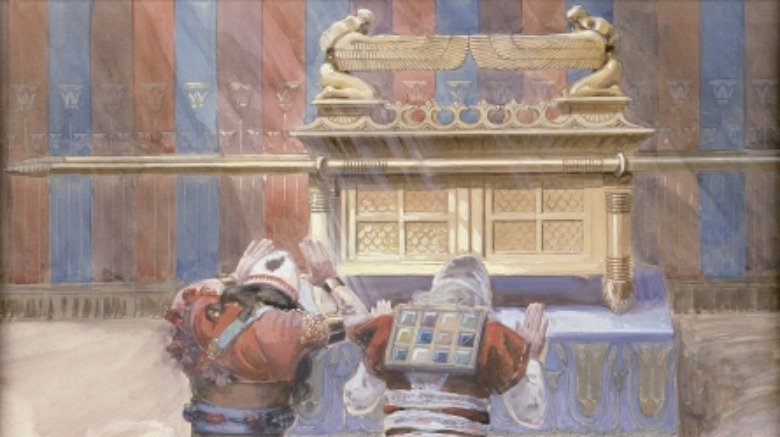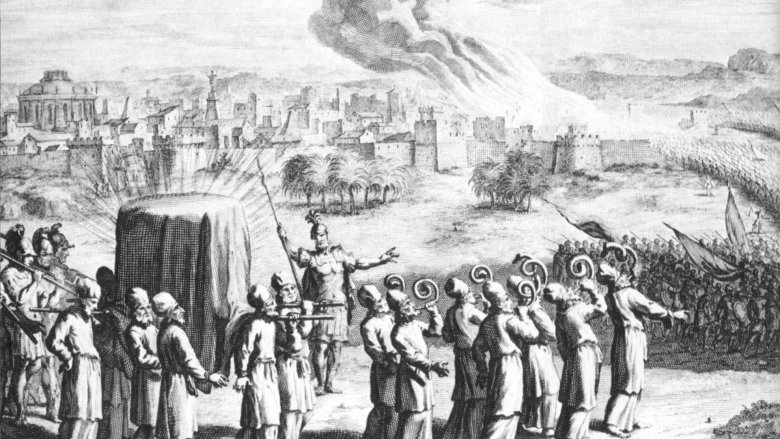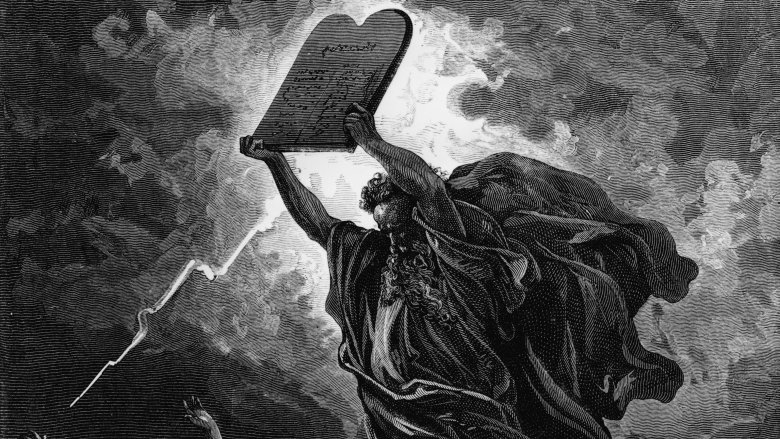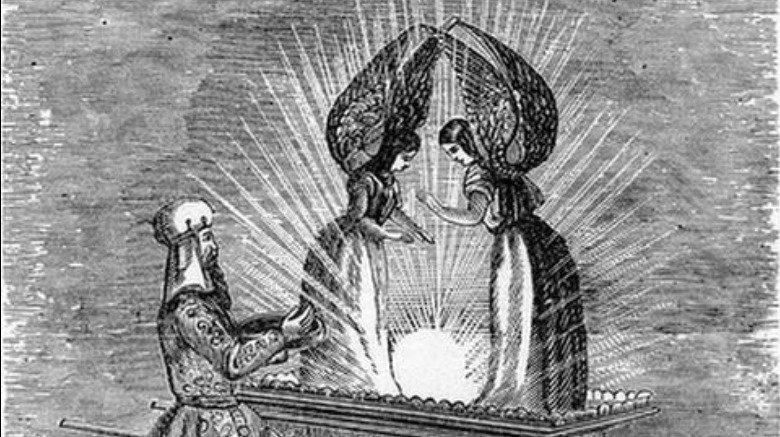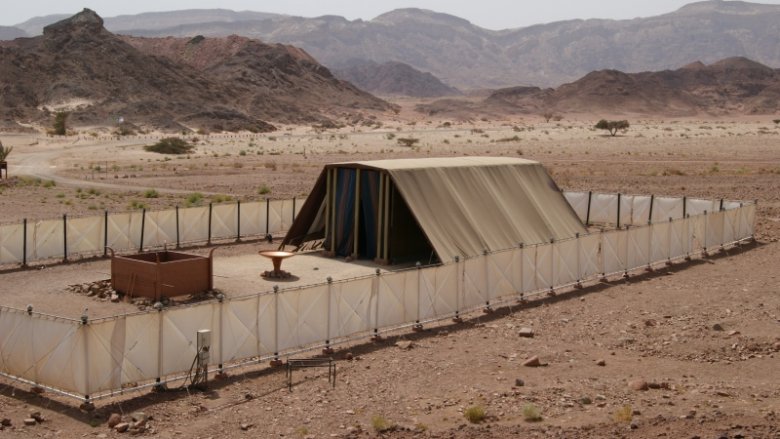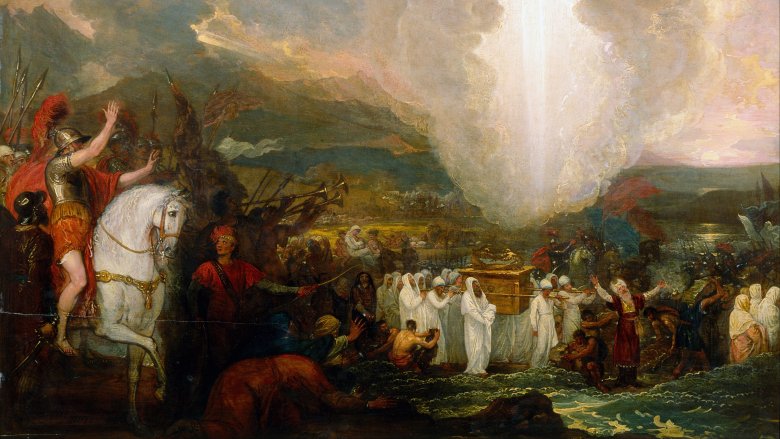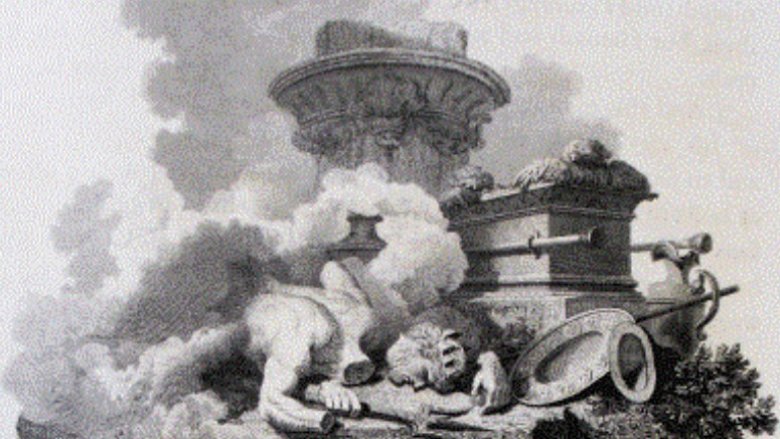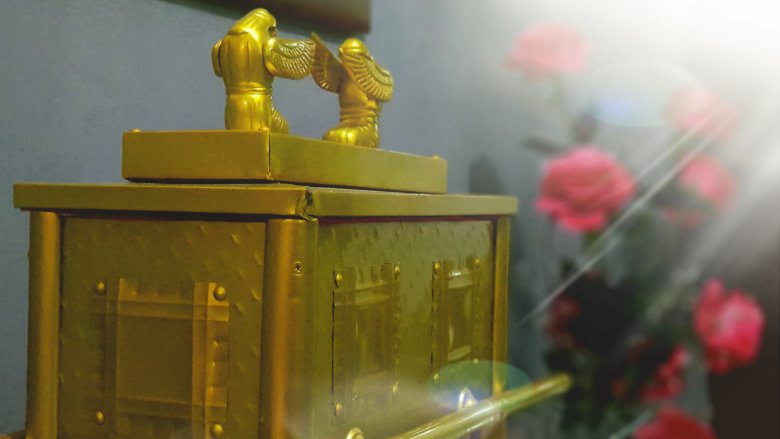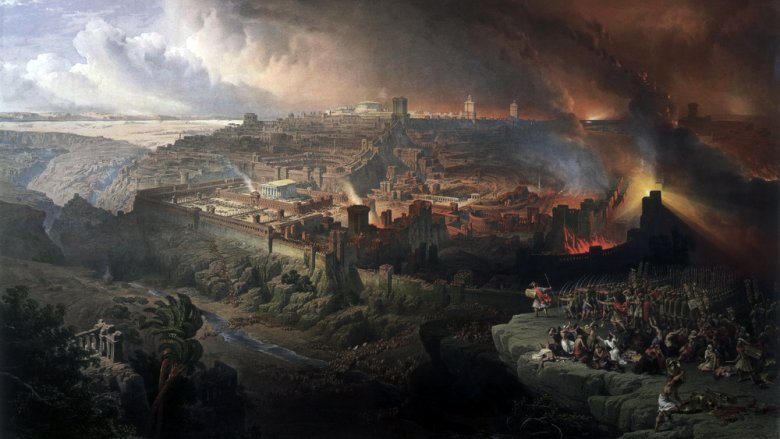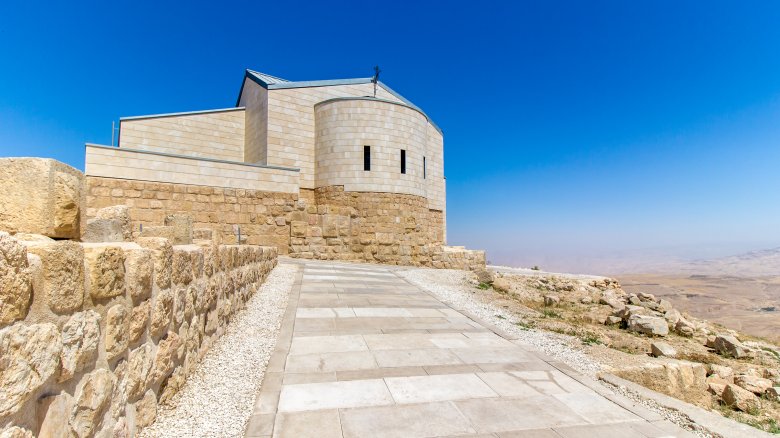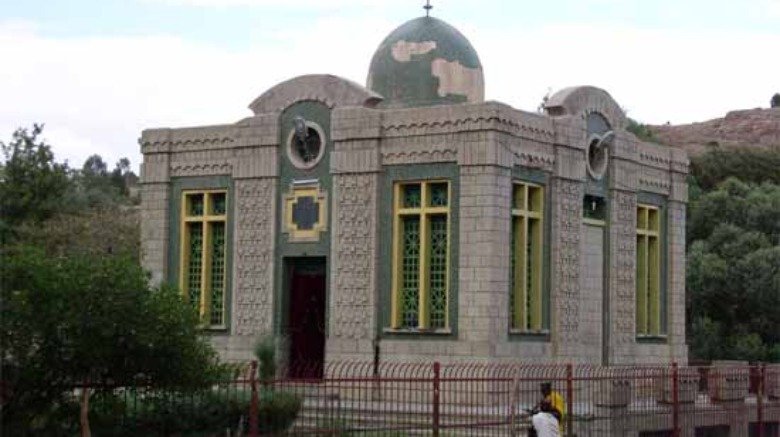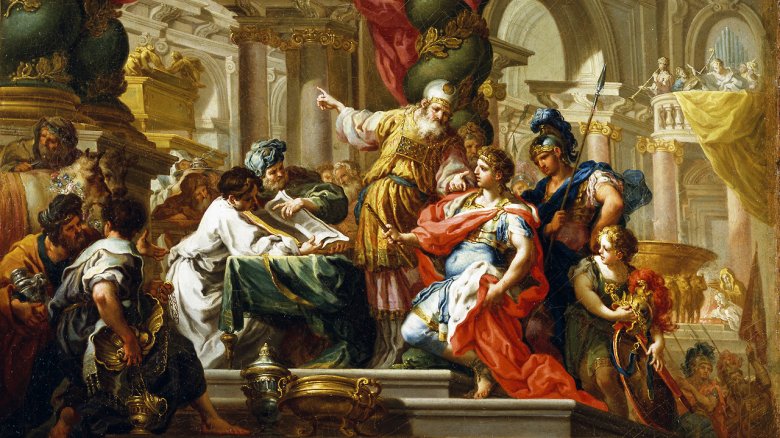The Untold Truth Of The Ark Of The Covenant
The Ark of the Covenant is one of the holiest artifacts of the Hebrew Bible. So holy, in fact, even looking at it or touching it could be deadly. Thanks to the massive success and cultural ubiquity of the 1981 film Raiders of the Lost Ark featuring two-fisted archaeologist Indiana Jones racing Nazi nogoodniks to the location of the miraculous chest, people have a basic conception of what the Ark of the Covenant is. That is to say, they know it's a thing that belongs in a museum and Nazis shouldn't have it and maybe it will shoot ghosts at you until you become a puddle of liquid skin and eyeball goo.
But what actually is the Ark of the Covenant? Is it the same as Noah's Ark? What's it for? What's in it? And, of course, where is it now? Read on for the surprising answers to all of these questions and even more face-melting information than you can handle.
So, what even is the Ark of the Covenant?
The Ark of the Covenant–also sometimes called the Ark of the Testimony or the Ark of God–is not, despite the prevalence of the perhaps more famous ark in the Bible, a boat. As the Online Etymology Dictionary explains, the word "ark" comes from the Latin word arca, meaning "big box." Just as Noah's ark was a big floating box for him to put animals in, the Ark of the Covenant was a big box full of things important to God that would represent his presence among the people of Israel as they wandered through the desert after escaping slavery in Egypt.
The Jewish Encyclopedia explains the Ark was basically a movable sanctuary for the Israelites, kind of like a place for God to sit until they arrived in the promised land and could establish a temple there. The Ark was fully sacrosanct, not to be touched and not even to be looked at uncovered. When on the move, the Ark was always covered by skins and cloths, hidden even from the priests who carried it. When stationary, it was held up by poles so it wouldn't touch the ground. Even the high priest was forbidden from being in the place of the Ark except when necessary to perform certain rituals and ceremonies. In this regard–and only this regard–God is kind of like Sheldon from Big Bang Theory: they're both very territorial about where they sit.
Contents of the Ark of the Covenant
In Exodus chapter 25, after God has given Moses the Ten Commandments on Mount Sinai, he gives him detailed instructions about building the Ark of the Covenant and the Tabernacle to house it in (as well as a lot of other stuff; the back half of Exodus is basically a stack of furniture assembly instruction manuals). The Ark is to be made out of shittim wood, which sounds hilarious, but is actually just acacia. The dimensions of the box are roughly 4.5 feet by 2.5 feet by 2.5 feet, and the whole thing is covered in gold, with a gold ring at each corner for acacia wood rods to be placed through for carrying and holding the Ark off the ground. The whole thing is then covered with a special lid made entirely of gold, which you'll see in a second.
So what goes in this fancy box? In various places in the Hebrew Bible, the Ark is said to hold the tablets on which the Ten Commandments were carved and a pot full of manna, the miraculous coriander-like food God provided for the Israelites to eat as they wandered the wilderness. The Christian Epistle to the Hebrews, however, also mentions it contained a staff belonging to Aaron (Moses's brother) that miraculously grew flowers and almonds in the Book of Numbers.
The secret of the Ark of the Covenant's lid
The lid of the Ark was known in Hebrew as the kaporet, a word that comes from a root meaning "to atone" and which is related to the Jewish Day of Atonement, Yom Kippur. While a more accurate translation of this word into English might be "propitiatory," the traditional rendering of the name of the Ark's lid is "the mercy seat." As the Christian Apologetics and Research Ministry explains, the mercy seat was a lid of pure gold placed on the Ark and put within the Holy of Holies behind the veil of the Tabernacle, where God himself actually showed up and the High Priest would go once a year to sprinkle blood as a sacrifice to calm God down for another year.
The ends of the lid were shaped into two cherubim (i.e., angels) facing each other, and it was between these angels the presence of God was manifested. The offerings of blood and incense were placed there, and according to Exodus, it's where God would literally sit and talk to Moses, and it was from this seat God would execute justice. The two angels are pretty traditionally depicted as being two androgynous humans with wings, but the Book of Ezekiel describes cherubim as being four-headed mashups of humans, eagles, lions, and oxen, so that box may have actually been way freakier than modern artists usually envision.
The Ark of the Covenant was kept in a tent made of unicorn skin
While the Israelites marched through the desert, the Ark usually led the way, but whenever they set up camp, the Ark was placed within a temporary shelter known as the Mishkan, or Tabernacle. According to Exodus, the Tabernacle was basically a tent made up of layers of curtains and veils supported by wooden pillars with a separate, sacrosanct area for the Ark itself called the Holy of Holies, with the outer sanctuary containing the seven-lamped menorah.
One of the most interesting mysteries about the Tabernacle, however, is just what the outer tents were made of. The Hebrew word for the skins is tachash, and nobody really knows what animal that is. A comparison of different translations of Exodus 26:14 shows tachash is variously rendered as "goatskin," "porpoise skin," "badger skin," "manatee skins," "dolphin skins," or "seal skins." Besides these being a wide array of beasts to choose from, where would a bunch of desert wanderers get their hands on an abundance of manatee skin?
Chabad tells that Jewish midrashim (biblical commentaries) offer a more interesting explanation. They say the tachash was, in fact, an enormous wild animal with a single horn, 50 feet long, and covered with skin of six colors. Yes, that's right, the special tent for the Ark of the Covenant was made of the skin of an enormous rainbow unicorn. God has Lisa Frank taste.
The miraculous powers of the Ark of the Covenant
As a receptacle of holy items that doubles as God's special chair, the Ark of the Covenant was no ordinary box. The Bible shows it to possess a great power to destroy the enemies of God or remove obstacles that stood in his chosen people's way.
In the Book of Joshua, when Moses's successor Joshua led the Israelites into the Promised Land (Bible spoilers: Moses didn't make it), the Ark parted the waters of the Jordan River so the Israelites could cross on dry land, in a tidy echo of the parting of the Red Sea that began their sojourn into the desert. Likewise, the Ark was carried around the city walls when, as the song goes, Joshua fit the Battle of Jericho, and the walls came tumbling down.
The sacrosanct nature of the Ark was no joke, either. The Book of Samuel records the people of the city of Beth-shemesh looking at the Ark out of curiosity, and–depending on the translation–either 70 or 50 thousand of them died immediately, presumably with their faces melting like at the end of Raiders. Even those with good intentions weren't spared if the Ark was profaned by human touch. 2 Samuel tells the story of a guy who reached out to steady the Ark when it was about to topple off an ox cart. Despite trying to be helpful, he was struck immediately dead by divine fire.
The Ark of the Covenant smashes the Philistine fish god
One of the grandest displays of the power of the Ark comes in the Book of Samuel when the Ark is stolen by the Philistines, which today is a word we use to mean people who don't like cool music, but in Bible times referred to Canaanite enemies of the ancient Israelites. The Israelites took the Ark out to battle against the Philistines hoping it would help them in the fight and it, uh, didn't. The Philistines stole the Ark and took it back to their own country, where they placed it in the temple of Dagon (yes, the fish god Lovecraft wrote about).
This doesn't go great for Dagon or the Philistines. The next morning, the idol of Dagon is found face down on the ground, bowing before the Ark,. They put the idol back in its place, but the morning after that it was found bowing to the Ark again, this time broken into pieces. The people of the surrounding city found their bodies covered with tumors and their field overrun with mice. When the Philistines moved the Ark to other cities, the inhabitants of these new cities found themselves afflicted with boils. After seven months of this, the Philistines returned the Ark to the Israelites together with a tribute of golden statues representing the tumors and mice they'd been plagued with for stealing God's stuff.
Further powers of the Ark of the Covenant
When you step outside the explicit text of the Hebrew Bible, more traditions surrounding the powers of the Ark are ripe for the picking. The Jewish Encyclopedia records, for example, the Ark not only protected the Israelites from their human enemies within the Promised Lands, but from natural obstructions found within the desert on their way there. The story goes, two sparks would form in between the two cherubim of the mercy seat and basically fire lasers that cleared the path of snakes, scorpions, and thorn bushes. Furthermore, the smoke produced by these lasers smelled like sweet perfume that filled the whole world so surrounding nations would ask, "Wow, what smells so good?" and the answer would be "God's chair is on its way."
The Ark is, of course, also mentioned in the Quran, but other Islamic sources discuss it as well, including one that adds to the contents of the Ark Moses' hat, robes, and shoes. Perhaps most interestingly, however, comes the story recorded in the book Sudanese Memoirs, which tells of how the Ark contained a ruby statue that looked like the head of a cat with two wings. The cat, despite being a statue, was vocal, and meowed like the roaring of the wind. When it cried out, it caused the Ark to rush toward God's enemies and assured victory for the Israelites.
The Ark of the Covenant becomes the Lost Ark
The Ark of the Covenant features heavily in the Hebrew Bible from the time of Moses through the eras of King David and Solomon, and even into the time of the Divided Kingdom, but basically disappears from the record around the time of the prophet Jeremiah. What happened at that time that might account for such an important artifact disappearing from history?
Well, Jeremiah lived at the end of what is known as the First Temple period. As Chabad explains, the First Temple is the one constructed by King Solomon (possibly with the assistance of a horde of enslaved demons) based on the plans of his father, David. After seven years of work, the great temple was completed and the Ark of the Covenant placed inside, in a new, more permanent Holy of Holies that was not made of rainbow unicorn skin. The end of the First Temple period came several centuries later after Israel split into two nations. The Northern Kingdom of Israel fell to the Assyrians in 722 BCE, and the Southern Kingdom of Judah (where the temple was) was conquered by the Babylonian Empire in 587 BCE, the temple was destroyed, and the people of Judah were sent into exile.
So what happened to the Ark? Taken to Babylon? Hidden in ruins? No one knows. But boy howdy, do people have ideas.
Is the Ark of the Covenant in Jordan?
One proposed location of the Ark of the Covenant comes from the book 2 Maccabees, one of a group of Greek Jewish texts thought by Christians as happening between the Old and New Testaments and referred to variously as the Apocrypha or the Deuterocanon, depending on what kind of church you go to. The books of the Maccabees describe the conflicts of the Jewish people with the Greek successors of Alexander the Great and how a great military leader named Judah Maccabee ("the Hammer") and his brothers led a successful revolt that led to the restoration of the Second Temple (this is what Hanukkah is about) and ultimately to the Jewish people enjoying autonomous rule until the Romans showed up. The Maccabees are pretty rad reads, full of armies of ghosts and a dude so mad at the Greeks he threw his own intestines at them.
Anyway, chapter two of 2 Maccabees is a flashback to the time of the Babylonian siege, and tells how the prophet Jeremiah, applying the kind of foresight unique to prophets, grabbed the Ark, the Tent of Meeting, and the temple altar and absconded with them to "the mountain where Moses had gone up and had seen the inheritance of God," which is Mount Nebo, currently in the country of Jordan, to be hidden there until such time as God decides to reveal it.
Is the Ark of the Covenant in Ethiopia?
Not everyone agrees with the theories the Ark was taken to Babylon, or hidden in Jerusalem, or sealed in a cave on Mount Nebo. Namely, Ethiopian Christians have claimed for centuries the Ark of the Covenant is, in fact, in the Ethiopian city of Aksum (also spelled Axum). As Smithsonian explains, the Christians of Ethiopia claim the Ark came to Aksum some three millennia ago and has been fiercely guarded by a succession of virgin monks who dedicate their lives to keeping watch over the Ark in the chapel and are forbidden to step foot outside once anointed to this duty.
The Ethiopian chronicle known as Kebra Negast ("The Glory of Kings") records when the Queen of Sheba (i.e., Ethiopia) went to visit Solomon to consult his fabled wisdom, she got pregnant with his son, named Menelik. When Menelik later visited his father, some Israelite nobles accompanied him on his return trip. Unknown to Menelik, these nobles had stolen the Ark and replaced it with a fake. Since Menelik had borne the Ark all the way to Ethiopia without being destroyed, he knew it had to have been God's will. And allegedly, the Ark has been in Aksum's Church of Our Lady Mary of Zion more or less ever since. Since no one but the Ark's guardian is allowed to see it, who can dispute it?
Did the Knights Templar get up to Ark of the Covenant shenanigans?
There's no biblical artifact so famous someone won't claim it was recovered by the Knights Templar and taken from the Holy Land back to Europe somewhere. As Crusader History explains, French author Louis Charpentier argues the Templars, not satisfied with having attained the Holy Grail, apparently removed the Ark of the Covenant from the ruins of Solomon's temple and took it back to the French Cathedral of Our Lady of Chartres. The theory is the Templars, in their roles as master stonemasons (on top of being bodyguards for Crusaders), were the ones to rebuild Chartres Cathedral as an exquisitely carved Gothic cathedral after it had burnt down, with the intention of it being a great storehouse for holy relics and wisdom. The evidence of this can be found in reliefs depicting the transportation of the Ark.
The Leamington Courier reports, however, that British author Graham Phillips argues the Templars took the Ark not to France, but to–wait for it–Britain. In Phillips's reconstruction of events, the Templar leader Ralph de Sudeley found the Ark among the hidden stash on Mount Nebo and carried it back to his estate in Warwickshire. Phillips asserts among the rubble of a church there was found a tablet inscribed with strange symbols he believes to be one of Moses's tablets. There's some pretty Da Vinci Code-esque apophenia in there, too, if that's your thing.
Was Alexander the Great buried with the Ark of the Covenant?
One of the most recent claimants to being the location of the Ark of the Covenant is the alleged tomb of Alexander the Great on the Greek island of Thasos. According to the Huffington Post, in 2012 an amazingly sketchy archaeological outfit announced they'd uncovered the final resting place of one of history's greatest conquerors, and–wouldn't you know it?–they found the Ark of the Covenant inside. Thasos, which is near Macedonia, where Alexander was from, has long been rumored to be where The Great One was buried, so the announcement of finding his tomb there is not entirely out of left field. But why would the Ark of the Covenant be there?
Well, according to the Jewish historian Josephus, Alexander did in fact go to Jerusalem, where he was shown a copy of the Book of Daniel, which prophesied a great Greek leader would conquer the Persians. Seeing this, he was satisfied and left Jerusalem alone. Definitely no mention of him taking one of the holiest items of the Jews along with him, which had been missing for centuries since the destruction of the First Temple and never found for the construction of the Second Temple. It seems like Josephus would have mentioned that, but maybe he was having an off day. Crazier things have happened.
